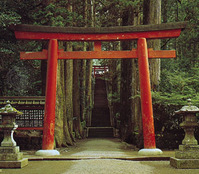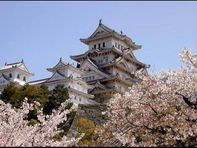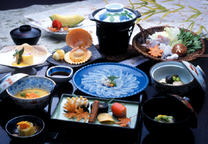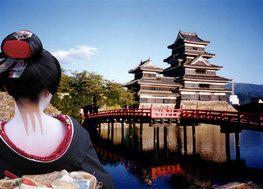Japan's Background
Origins
Before all the aspects of Japanese culture can be understood, the history behind the Japanese first needs to be known. Where exactly did the Japanese come from? This is probably the single most debatable question regarding Japan in the world today. The answer is still unclear. Not much evidence is available to prove the existence of the Japanese in Japan before 700 BC (“Jomon”). The origins of the Japanese are based majorly on theories and myths. Everyone seems to have their own opinion on the origins of Japanese heritage. Of which, there are three popular theories that exist in our world today (Diamond).
The first theory, that appeals to most Japanese, explains that the Japanese are descendants of Jomon hunter-gathers that travelled to Japan around 14000 BCE and settled themselves in what is known as present day Japan (“Jomon”). Since the Jomon people were already accustomed to living in villages, they were easily able to pick up agriculture (“Japanese History”). In addition, it was their culture and agricultural skills that had evolved over time and was passed down to the modern Japanese. The reason why this theory is well-liked among the Japanese is because it limits any genetic connection to Koreans and other Asians (Diamond).
A second theory, and one that most western archeologist tend to agree with, is the theory that the Japanese are descended from Koreans who immigrated to Japan during the transition of the Jomon period to the Yayoi period of Japan (Diamond). Japan’s Island, Kyushu, was warm and swampy, which is the perfect requirements to grow rice, and such there was a mass immigration of Korean farmers who came to set up some rice paddies (Diamond). With them they brought culture, farming techniques, and their heritage. They then mixed in with the pre-existing Jomon people and created a new lineage (Jared). This would explain why biologically, the Japanese most commonly resembles Koreans over other Asians (“The Origins”). The Korean language as well has the closest link to the Japanese (“The Origins”). However, there is only about a 15% relation of vocabulary between the two (Diamond). To explain Japan’s unique language, they believe that it was adapted from the Korean immigrants’ need for a new language and writing system because of their illiteracy during that time. They were then later influenced by the Chinese where they obtained nearly 50% of their vocabulary (Diamond). Although this theory proves some very good points, most Japanese strongly disagree with it, because they continually stress the claim that they are a homogeneous race.
The last theory also accepts the concept of Korean immigration except that it does not agree that it was a mass immigration (Diamond). Instead, they believe that only a handful of Korean farmers immigrated to Japan (Diamond). Conditions were so well-off that they were able to reproduce at a rapid pace (Diamond). They were able to produce more offspring than the Jomon people and soon outnumbered them (“Jomon”). This is basically the same as the second theory except it denies the need for large immigration.
Regardless of the origins of the Japanese, the nation of Japan is claimed to have been founded by ancestral Emperor Jimmu during the 7th century BCE (“The Origin”). It was then during the 6th and 5th century BCE that the Chinese culture was introduced through the Korean peninsula. The Chinese writing system and Buddhism as well as Chinese traditions and other cultural aspects greatly influenced the Japanese (“The Origin”). Japan’s way of ruling had also been adapted from Chinese customs. Japan already had existing Emperors, but now had spread its power among the newly assigned court nobles, shoguns, and regents (“The Origin”). In the 16th century BCE, merchants from the Netherlands, Portugal, Spain, England, as well as Christian missionary began arriving on the shores of Japan (“Japanese History”). The Japanese felt threatened and believed that the Europeans had an underlining plan to dominate over their country. The result created a 251 year long isolation of Japan from all other countries except for a select few restricted Chinese and Dutch merchants (Diamond). It wasn’t until 1854 that Commodore Mathew Perry forced Japan to drop their isolation act and begin interactions with the West (Diamond).
The first theory, that appeals to most Japanese, explains that the Japanese are descendants of Jomon hunter-gathers that travelled to Japan around 14000 BCE and settled themselves in what is known as present day Japan (“Jomon”). Since the Jomon people were already accustomed to living in villages, they were easily able to pick up agriculture (“Japanese History”). In addition, it was their culture and agricultural skills that had evolved over time and was passed down to the modern Japanese. The reason why this theory is well-liked among the Japanese is because it limits any genetic connection to Koreans and other Asians (Diamond).
A second theory, and one that most western archeologist tend to agree with, is the theory that the Japanese are descended from Koreans who immigrated to Japan during the transition of the Jomon period to the Yayoi period of Japan (Diamond). Japan’s Island, Kyushu, was warm and swampy, which is the perfect requirements to grow rice, and such there was a mass immigration of Korean farmers who came to set up some rice paddies (Diamond). With them they brought culture, farming techniques, and their heritage. They then mixed in with the pre-existing Jomon people and created a new lineage (Jared). This would explain why biologically, the Japanese most commonly resembles Koreans over other Asians (“The Origins”). The Korean language as well has the closest link to the Japanese (“The Origins”). However, there is only about a 15% relation of vocabulary between the two (Diamond). To explain Japan’s unique language, they believe that it was adapted from the Korean immigrants’ need for a new language and writing system because of their illiteracy during that time. They were then later influenced by the Chinese where they obtained nearly 50% of their vocabulary (Diamond). Although this theory proves some very good points, most Japanese strongly disagree with it, because they continually stress the claim that they are a homogeneous race.
The last theory also accepts the concept of Korean immigration except that it does not agree that it was a mass immigration (Diamond). Instead, they believe that only a handful of Korean farmers immigrated to Japan (Diamond). Conditions were so well-off that they were able to reproduce at a rapid pace (Diamond). They were able to produce more offspring than the Jomon people and soon outnumbered them (“Jomon”). This is basically the same as the second theory except it denies the need for large immigration.
Regardless of the origins of the Japanese, the nation of Japan is claimed to have been founded by ancestral Emperor Jimmu during the 7th century BCE (“The Origin”). It was then during the 6th and 5th century BCE that the Chinese culture was introduced through the Korean peninsula. The Chinese writing system and Buddhism as well as Chinese traditions and other cultural aspects greatly influenced the Japanese (“The Origin”). Japan’s way of ruling had also been adapted from Chinese customs. Japan already had existing Emperors, but now had spread its power among the newly assigned court nobles, shoguns, and regents (“The Origin”). In the 16th century BCE, merchants from the Netherlands, Portugal, Spain, England, as well as Christian missionary began arriving on the shores of Japan (“Japanese History”). The Japanese felt threatened and believed that the Europeans had an underlining plan to dominate over their country. The result created a 251 year long isolation of Japan from all other countries except for a select few restricted Chinese and Dutch merchants (Diamond). It wasn’t until 1854 that Commodore Mathew Perry forced Japan to drop their isolation act and begin interactions with the West (Diamond).
Religion

("Shinto")
Japan holds a variety of different religions and as such may be considered a relatively religiously-tolerant people. Religions in Japan today include Shintoism, Buddhism, Confucianism, Christianity, and Islam. Shintoism is Japan's own unique religion and is believed to have originated from the Yayoi people between 400 BC and 240 AD ("Religion").
Japan's most popular religion is Buddhism which was influenced by China and Korea and celebrates Siddhartha Gautama as Buddha. Buddhism works to spread peace and tranquility through the eightfold path and the four noble truths ("Buddhism") Another popular religion in Japan is Shintoism. Shintoism is based on the Shinto Gods called "Kami" that humans become when they die ("Shintoism"). They live in all of nature and effects the weather and flow of life. The other religions, were also influenced by bordering countries and western nations but are still practiced by a minority in Japan.
Japan's most popular religion is Buddhism which was influenced by China and Korea and celebrates Siddhartha Gautama as Buddha. Buddhism works to spread peace and tranquility through the eightfold path and the four noble truths ("Buddhism") Another popular religion in Japan is Shintoism. Shintoism is based on the Shinto Gods called "Kami" that humans become when they die ("Shintoism"). They live in all of nature and effects the weather and flow of life. The other religions, were also influenced by bordering countries and western nations but are still practiced by a minority in Japan.
Architecture

("Oshiro")
Japanese traditional architecture was greatly influenced by Chinese architecture though influences of Korean architecture can be seen. With Chinese architectural influenced, Japanese buildings went from floor less dwellings to more innovated living spaces that could better withstand harsh weather conditions ("Architecture"). The shapes of the roofs wear made so that rain would roll of to the side of the house instead of leaking through like it did through the bundled straw they use to use, and floors made sleeping on the ground more comfortable during the winter. However, since most of Japan was centered around volcanic areas, their prominent building material was wood rather than stone ("Architecture").
Traditional Clothing

("Traditional")
Japan's traditional clothing, like architecture, was influenced by China and Korea. Types of clothing differed depending on status. Overall, Japanese clothing mainly overlapped and folded over a person's body, then a sash called an obi and would be used to tie it in place. Some traditional clothing is still worn today in special occasions, like holidays or festivals, such as kimonos or yukatas (Lad). Other traditional clothing includes Hakama (pants) Junihitoe (court lady dress), Uwangi (shirt worn with Hakama), Zori (Sandals), Geta (flip-flop like shoes), and much more (Lad).
Cuisine

("Washoku")
Japanese Cuisine has developed over thousands of years and offers a wide variety of dishes from traditional to more modern cuisine. Japanese traditional cuisine is referred to as "Nihon ryouri" or "washoku" and consists of dishes created before the end of the national seclusion in 1868 ("Types"). This include foods like sushi, noodles dishes like ramen and udon, and many other dishes of raw, dried, or cooked fish ("Types").
After Japan's national seclusion, Japan began to associate with other nation's more and were introduced new foods and ingredients. Japan the took these foods and ingredients and used them in their own unique way to create cuisine called "youshoku". Some youshoku dishes include, rice omelette, Japanese hamburger, Japanese Curry, and variety of Japanese styled stews ("Yohshoku").
After Japan's national seclusion, Japan began to associate with other nation's more and were introduced new foods and ingredients. Japan the took these foods and ingredients and used them in their own unique way to create cuisine called "youshoku". Some youshoku dishes include, rice omelette, Japanese hamburger, Japanese Curry, and variety of Japanese styled stews ("Yohshoku").
Arts

("Kabuki")
The Japanese Culture has a high appreciation of the arts, this includes visual arts, performing arts, and literature. The Japanese express this appreciation through a multitude of ways. In the visual arts, they can express it through calligraphy, which the art style of writing as well as through their beautiful sculptures and paintings. In the Performing arts, the express it threw their body in the 4 traditional theaters; noh, kyogen, kabuki, and bunraka ("Theater"). In literature, it comes out on paper in the form stories and poems such as the Japanese Haiku.

